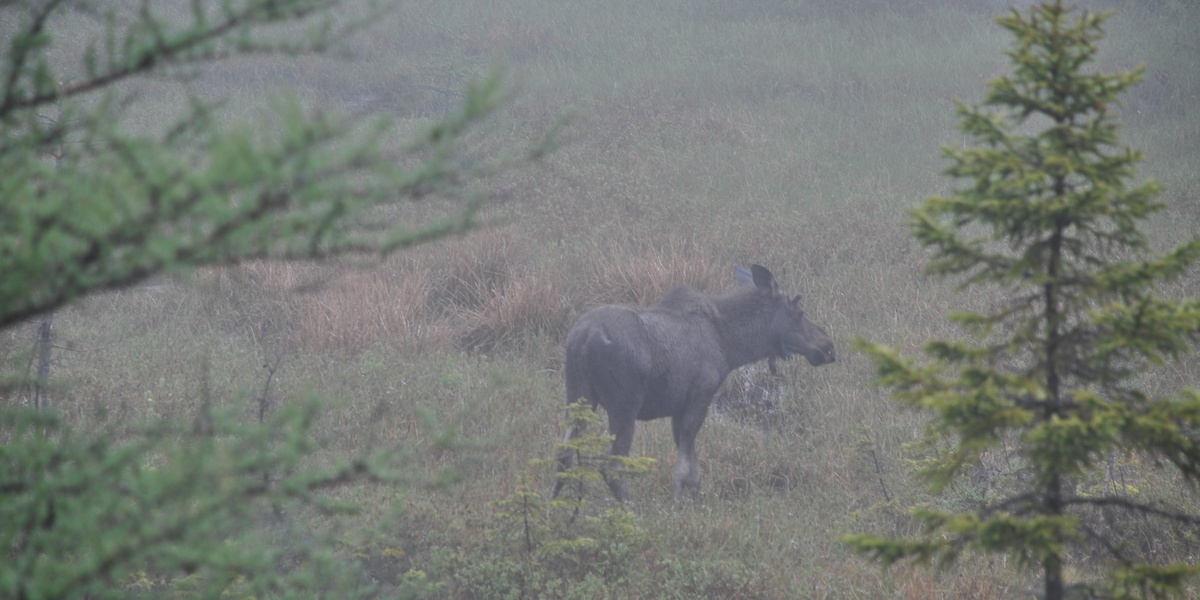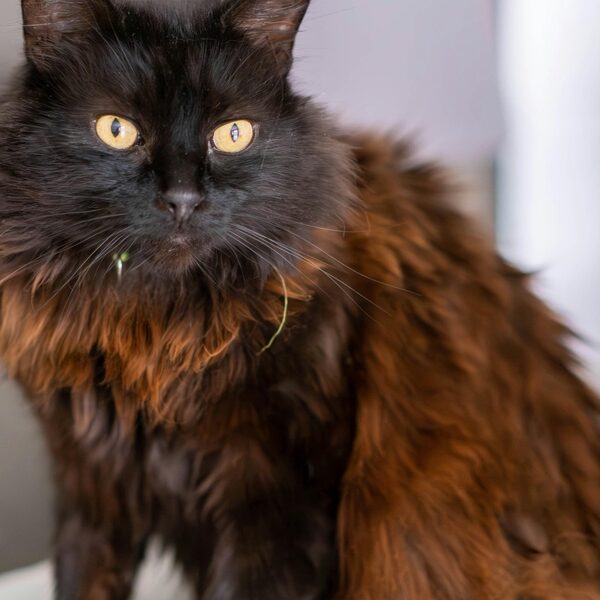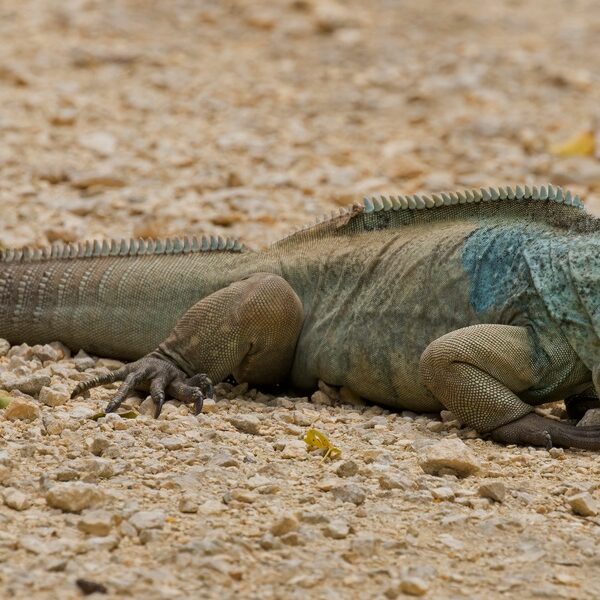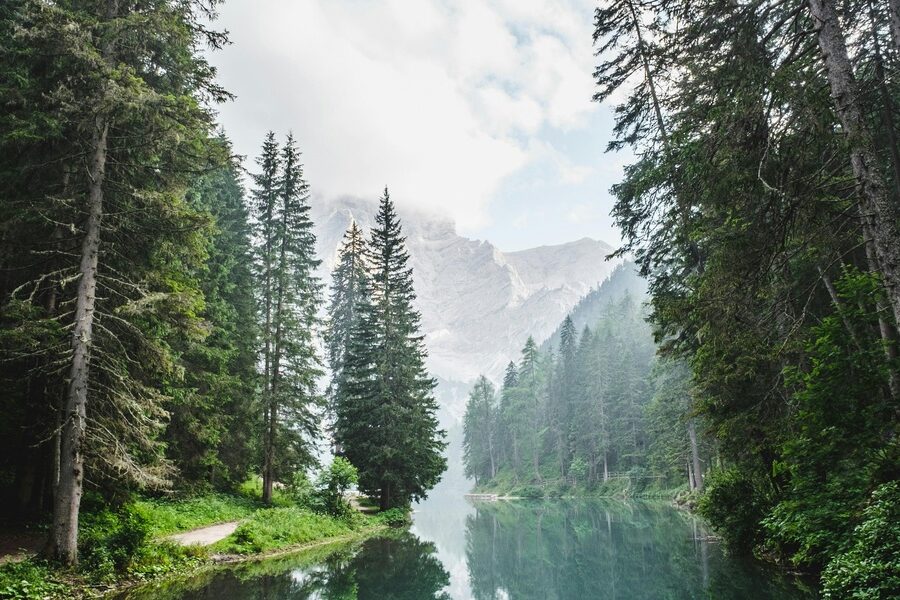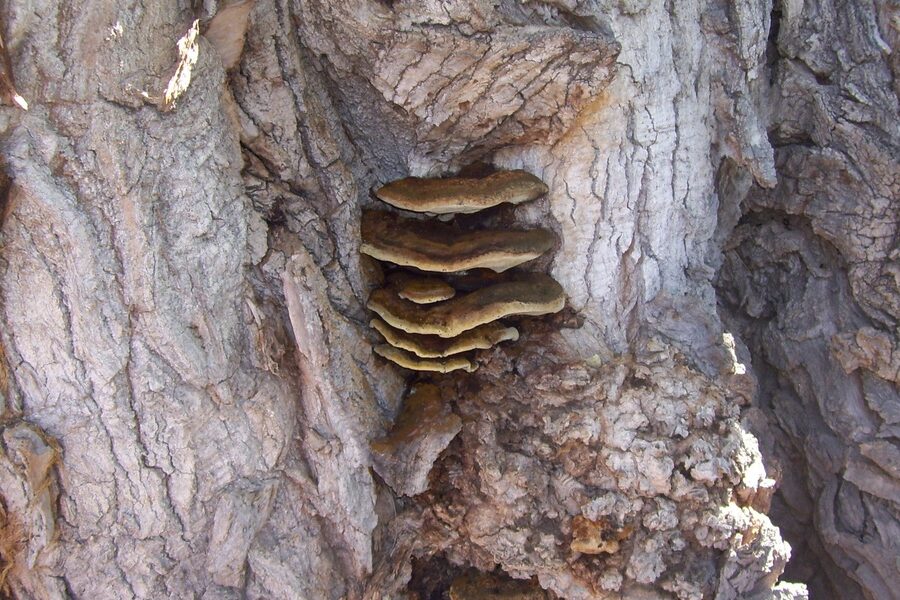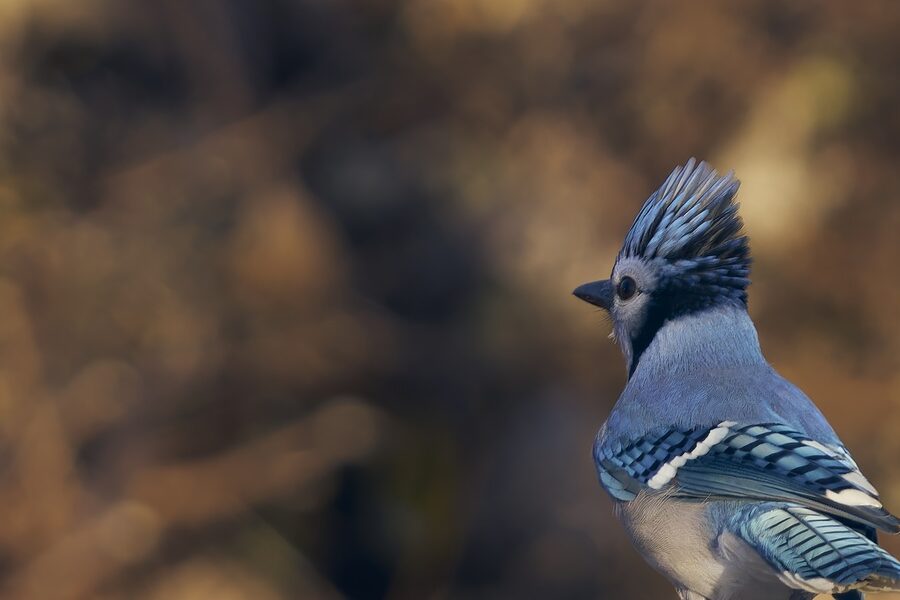The boreal forest, also known as the taiga, is a vast, cold biome stretching across the northern latitudes of the globe. Characterized by its dense conifer forests, long, harsh winters, and short, intense summers, it’s a challenging environment that has shaped a unique array of life. Yet, despite its formidable conditions, this immense ecosystem teems with incredible biodiversity.
To thrive in such extremes requires specialized adaptations, and the animals that call this forest home are truly remarkable. Below, you’ll find a comprehensive list of boreal forest fauna, featuring 52 species that demonstrate this resilience, ranging from the powerful American Black Bear to the nimble Yellow-rumped Warbler. Each entry provides key details, including their Scientific Name, Diet & Key Adaptations, and Avg Weight (kg), to give you a deeper understanding of these fascinating creatures.
How do animals survive the harsh boreal winter?
Boreal forest animals employ diverse strategies to survive harsh winters. Many, like bears, hibernate to reduce metabolic activity. Others, such as snowshoe hares, develop thick insulating fur, sometimes changing color for camouflage. Birds often migrate south, while smaller mammals burrow under snow for warmth, foraging on cached food or beneath the snowpack.
What makes boreal forest fauna unique?
Boreal forest fauna are unique due to specialized adaptations for a challenging environment. Species often show resilience to extreme cold, dietary flexibility for seasonal food availability, and larger body sizes for heat conservation. Their lives are deeply connected to the dominant conifer trees for shelter and food, making their existence profoundly influenced by long winters and intense, short summers.
Boreal Forest Fauna
| Common Name | Scientific Name | Diet & Key Adaptations | Avg Weight (kg) |
|---|---|---|---|
| Moose | Alces alces | Herbivore (twigs, bark, aquatic plants). Long legs for deep snow and wading; large, heat-retaining body; specialized nose for browsing. | 450 |
| Woodland Caribou | Rangifer tarandus caribou | Herbivore (lichens, sedges). Hollow hair for insulation; large, crescent-shaped hooves act as snowshoes and paddles; can digest lichens. | 150 |
| Gray Wolf | Canis lupus | Carnivore (moose, caribou, beaver). Social pack hunter; exceptional stamina for long chases; thick, insulating fur coat; powerful jaws. | 40 |
| Grizzly Bear | Ursus arctos | Omnivore (berries, roots, fish, mammals). Large shoulder hump of muscle for digging and power; long claws; excellent sense of smell; hibernates in winter. | 220 |
| American Black Bear | Ursus americanus | Omnivore (berries, nuts, insects, carrion). Excellent climber with short, curved claws; opportunistic diet; hibernates in dens to survive winter food scarcity. | 125 |
| Canada Lynx | Lynx canadensis | Carnivore (primarily snowshoe hares). Huge, furred paws act as snowshoes; long ear tufts enhance hearing; dense, insulating fur; cryptic coloration. | 10 |
| Wolverine | Gulo gulo | Omnivore/Scavenger (carrion, small mammals, berries). Powerful jaws to crush bone; dense, frost-resistant fur; large paws for snow travel; tireless and ferocious. | 14 |
| Wood Bison | Bison bison athabascae | Herbivore (grasses, sedges). Massive head and shoulder muscles to sweep away snow for forage; thick, shaggy coat for extreme cold. | 750 |
| Snowshoe Hare | Lepus americanus | Herbivore (twigs, bark, buds). Large, furred hind feet act as snowshoes; coat changes from brown to white for seasonal camouflage. | 1.5 |
| American Marten | Martes americana | Carnivore (squirrels, voles, birds). Slender, agile body for climbing trees; semi-retractable claws; high metabolism; hunts under snow in winter. | 1 |
| Fisher | Pekania pennanti | Carnivore (snowshoe hares, porcupines, squirrels). One of the few specialized predators of porcupines; agile climber; fierce and solitary hunter. | 4 |
| Ermine | Mustela erminea | Carnivore (mice, voles, shrews). Long, slender body to enter burrows; high metabolism requires constant hunting; coat turns pure white in winter for camouflage. | 0.1 |
| North American Beaver | Castor canadensis | Herbivore (bark, cambium, twigs). Large incisors for felling trees; webbed hind feet and flat tail for swimming; builds dams and lodges, creating essential wetlands. | 20 |
| North American River Otter | Lontra canadensis | Carnivore (fish, amphibians, crayfish). Streamlined body and powerful tail for swimming; dense, waterproof fur for insulation; playful and social. | 8 |
| Muskrat | Ondatra zibethicus | Omnivore (aquatic vegetation, clams, frogs). Partially webbed feet and rudder-like tail for swimming; builds lodges or burrows in banks; can stay submerged for long periods. | 1.2 |
| Red Fox | Vulpes vulpes | Omnivore (rodents, hares, birds, berries). Excellent hearing to detect prey under snow; bushy tail (brush) for warmth and balance; highly adaptable. | 5 |
| Coyote | Canis latrans | Carnivore (hares, rodents, deer fawns). Highly adaptable diet and habitat use; intelligent; social but often hunts alone or in pairs. | 13 |
| North American Porcupine | Erethizon dorsatum | Herbivore (bark, twigs, buds). Defended by approximately 30,000 sharp quills; slow-moving and an excellent climber; strong teeth for gnawing wood. | 9 |
| Red Squirrel | Tamiasciurus hudsonicus | Omnivore (conifer seeds, fungi, berries). Creates large stashes of cones (middens) for winter survival; highly territorial and vocal. | 0.2 |
| Northern Flying Squirrel | Glaucomys sabrinus | Omnivore (fungi, lichens, nuts, insects). Large, furred membrane (patagium) between wrists and ankles allows for gliding; large eyes for nocturnal vision. | 0.12 |
| Southern Red-backed Vole | Myodes gapperi | Omnivore (plants, fungi, insects). Active year-round, creating tunnels under the snow (subnivean space); key prey species for many predators. | 0.02 |
| Great Gray Owl | Strix nebulosa | Carnivore (voles, mice). Large facial disc funnels sound to asymmetrical ears, allowing it to pinpoint prey under deep snow; silent flight. | 1.2 |
| Northern Hawk Owl | Surnia ulula | Carnivore (voles, birds). Hunts by sight during the day (diurnal); perches atop trees like a hawk; has a long tail and pointed wings for fast flight. | 0.3 |
| Boreal Owl | Aegolius funereus | Carnivore (voles, shrews, mice). Nocturnal hunter with excellent hearing; small and elusive; nests in old woodpecker cavities. | 0.13 |
| Spruce Grouse | Falcipennis canadensis | Herbivore (conifer needles, buds). Specialized digestive system for a diet of toxic conifer needles; grows fleshy combs (pectinations) on its toes in winter to act as snowshoes. | 0.5 |
| Ruffed Grouse | Bonasa umbellus | Omnivore (buds, leaves, insects, fruits). Known for the male’s “drumming” sound made with his wings; can plunge into soft snow to roost and stay warm. | 0.6 |
| Common Raven | Corvus corax | Omnivore/Scavenger. Highly intelligent with problem-solving skills; large, powerful beak; acrobatic flyer; resident year-round. | 1.2 |
| Canada Jay | Perisoreus canadensis | Omnivore. Caches thousands of food items for winter using sticky saliva; excellent spatial memory; very bold and curious. | 0.07 |
| Boreal Chickadee | Poecile hudsonicus | Insectivore/Omnivore. High metabolism and dense feathers for cold; caches food; can lower body temperature at night to conserve energy. | 0.009 |
| American Three-toed Woodpecker | Picoides dorsalis | Insectivore (wood-boring beetle larvae). Stiff tail feathers for bracing on trunks; powerful beak for excavation; forages by flaking off bark. | 0.06 |
| Black-backed Woodpecker | Picoides arcticus | Insectivore (wood-boring beetle larvae). Dark back provides camouflage in burned forests; a “fire-follower” species that thrives in recently burned areas. | 0.07 |
| White-winged Crossbill | Loxia leucoptera | Granivore (conifer seeds). Bill tips are crossed to efficiently pry open conifer cones; nomadic, moving to find abundant cone crops. | 0.025 |
| Pine Grosbeak | Pinicola enucleator | Omnivore (buds, seeds, fruit, insects). Robust beak for crushing seeds and snipping buds; relatively tame; a year-round resident. | 0.055 |
| Common Loon | Gavia immer | Piscivore (fish). Solid bones (less buoyant) for diving; legs placed far back on body for powerful swimming; haunting, iconic calls. | 4 |
| Osprey | Pandion haliaetus | Piscivore (fish). Reversible outer toe and sharp spicules on feet for gripping slippery fish; can close nostrils when diving. | 1.6 |
| Bald Eagle | Haliaeetus leucocephalus | Piscivore/Scavenger. Large, hooked beak for tearing flesh; excellent eyesight; builds massive nests (eyries) in large trees. | 4.5 |
| Yellow-rumped Warbler | Setophaga coronata | Insectivore/Frugivore. One of the first warblers to arrive in spring and last to leave in fall; unique ability among warblers to digest the wax in bayberries. | 0.012 |
| White-throated Sparrow | Zonotrichia albicollis | Omnivore (seeds, insects, berries). Distinctive song often transcribed as “Oh, sweet Canada, Canada”; forages on the forest floor. | 0.026 |
| Hermit Thrush | Catharus guttatus | Insectivore/Frugivore. Renowned for its beautiful, ethereal, flute-like song; often forages on the ground. | 0.03 |
| Northern Pike | Esox lucius | Piscivore (fish, frogs, birds). Torpedo-shaped body for rapid acceleration; powerful jaws with sharp teeth; ambush predator that lies in wait. | 5.5 |
| Walleye | Sander vitreus | Piscivore. Large, glassy eyes with a reflective layer (tapetum lucidum) for excellent low-light vision; a popular game fish. | 4 |
| Lake Trout | Salvelinus namaycush | Piscivore. Largest of the char family; adapted to cold, deep, oxygen-rich lakes; can live for several decades. | 9 |
| Arctic Grayling | Thymallus arcticus | Insectivore. Large, sail-like dorsal fin; eats insects from the water surface; requires cold, clear water to survive. | 1 |
| Burbot | Lota lota | Piscivore/Invertivore. The only freshwater member of the cod family; nocturnal bottom-dweller with a single barbel on its chin. | 2 |
| Lake Whitefish | Coregonus clupeaformis | Invertivore (insects, crustaceans). Small, down-turned mouth for bottom feeding; an important food source for larger fish and humans. | 1.5 |
| Wood Frog | Lithobates sylvaticus | Insectivore. Can survive being frozen solid by producing a natural glucose-based antifreeze in its cells; one of the first amphibians to breed in spring. | 0.008 |
| Boreal Chorus Frog | Pseudacris maculata | Insectivore. Tiny size; loud, rising call sounds like a fingernail running over a comb; freeze-tolerant. | 0.003 |
| Canadian Toad | Anaxyrus hemiophrys | Insectivore. Burrows into soil to avoid freezing and dehydration; prominent bony crests (cranial crests) between its eyes. | 0.06 |
| Common Garter Snake | Thamnophis sirtalis | Carnivore (frogs, earthworms, fish). One of the world’s most cold-tolerant reptiles; often hibernates in large, communal dens (hibernacula). | 0.15 |
| Spruce Budworm | Choristoneura fumiferana | Herbivore (conifer needles). A native moth caterpillar that undergoes massive periodic outbreaks, defoliating vast areas of forest. | <0.001 |
| Mosquito | Culicidae family | Nectarivore (males) / Hematophage (females). Females require a blood meal for egg development; aquatic larval stage; extremely abundant. | <0.001 |
| Canadian Tiger Swallowtail | Papilio canadensis | Nectarivore (adult) / Herbivore (larva). Diapause (hibernation) as a chrysalis to survive winter; large and colorful. | <0.001 |
Images and Descriptions
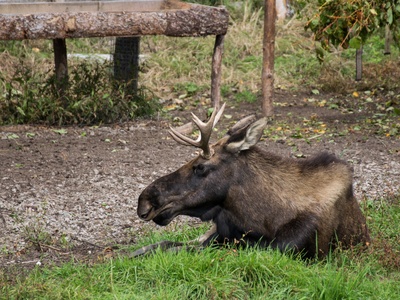
Moose
The largest member of the deer family, this iconic boreal giant is known for its immense size, palmate antlers, and long legs, which are perfectly adapted for navigating deep snow and wetlands.

Woodland Caribou
A crucial boreal species, the woodland caribou is uniquely adapted to survive on lichens in winter. Its large, splayed hooves allow it to walk on snow and dig for food.
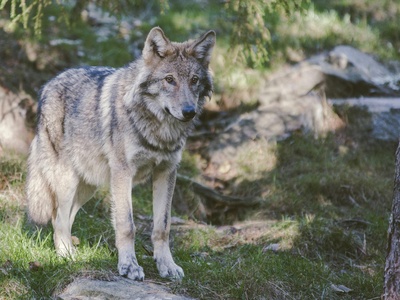
Gray Wolf
An apex predator of the taiga, the gray wolf plays a vital role in maintaining ecosystem health. It is a highly intelligent and social animal that hunts in cooperative packs to take down large prey.
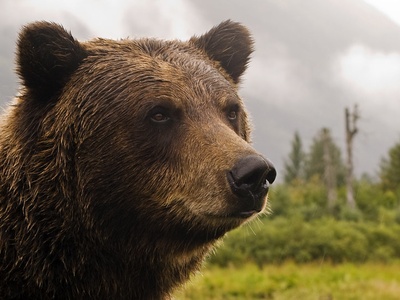
Grizzly Bear
This powerful and adaptable omnivore is a keystone species in many boreal ecosystems. Grizzly bears are opportunistic feeders, consuming everything from berries and roots to salmon and moose calves before their long winter hibernation.
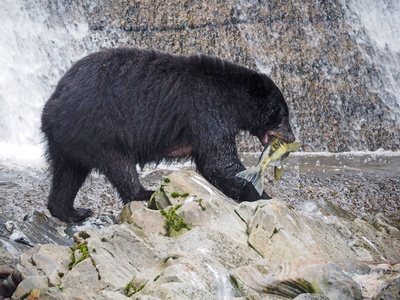
American Black Bear
The most common bear in North America’s forests, the American black bear is an intelligent and adaptable omnivore. It spends its summers fattening up on a varied diet before its long winter sleep.
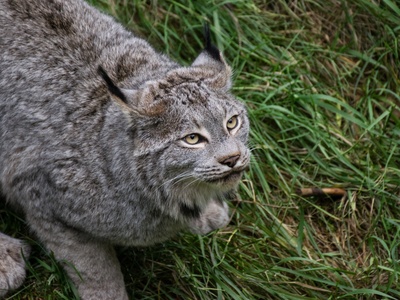
Canada Lynx
A secretive and elusive wild cat, the Canada Lynx is a specialist predator perfectly adapted to hunt snowshoe hares. Its population numbers famously rise and fall in a 10-year cycle with its main prey.
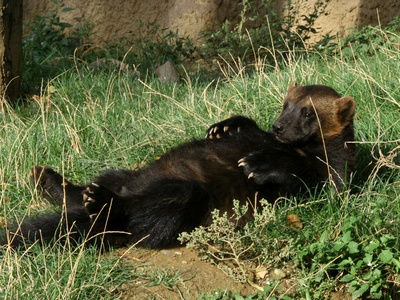
Wolverine
A legendary and solitary member of the weasel family, the wolverine is renowned for its ferocity, strength, and incredible endurance, capable of traveling vast distances through rugged, snowy terrain.
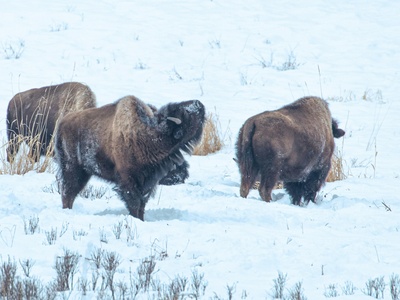
Wood Bison
The largest land animal in North America, the wood bison is a grazer of boreal meadows and parklands. Its immense size and thick coat make it well-suited to the cold northern winters.
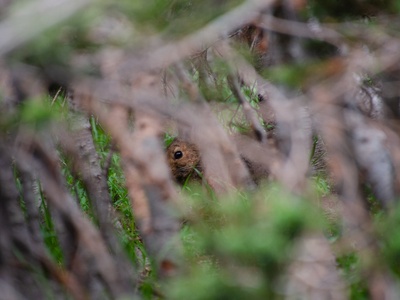
Snowshoe Hare
This keystone herbivore is famous for its dramatic 10-year population cycles and its remarkable seasonal camouflage. It is a critical food source for many boreal predators, especially the Canada Lynx.
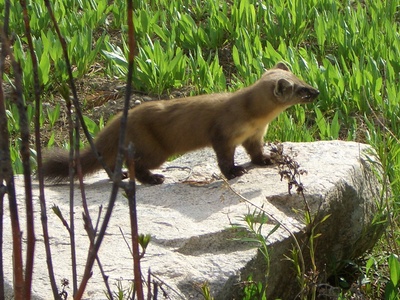
American Marten
A swift and agile member of the weasel family, the American marten is a skilled tree-climber and an effective predator of red squirrels and other small animals in dense conifer forests.
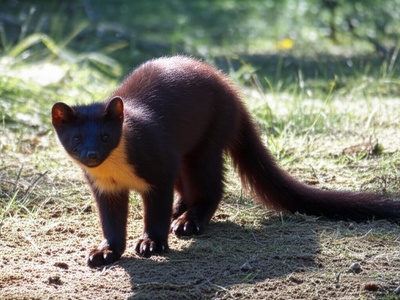
Fisher
Despite its name, the fisher does not eat fish. It is a large, powerful member of the weasel family and a fearsome predator, known for its unique ability to hunt and kill porcupines.
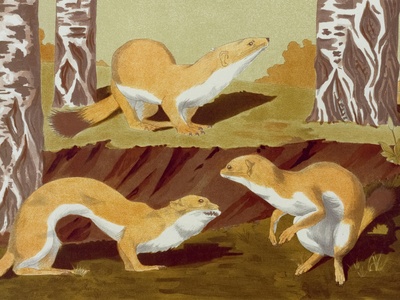
Ermine
Also known as the short-tailed weasel, the ermine is a small but fierce predator. Its coat famously turns from brown to a brilliant white in winter, providing perfect camouflage for hunting in the snow.
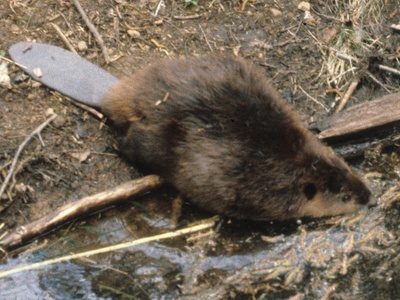
North American Beaver
This industrious rodent is a true ecosystem engineer. By building dams and creating ponds, the beaver transforms the landscape, creating vital wetland habitats for countless other species.
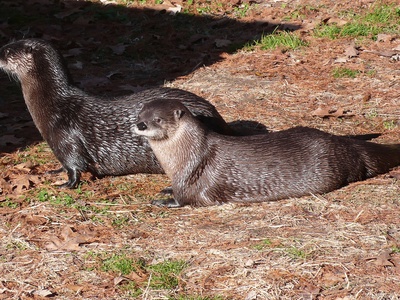
North American River Otter
A sleek and playful predator of boreal rivers and lakes, the river otter is perfectly at home in the water. Its dense, waterproof fur keeps it warm even in the coldest of streams.
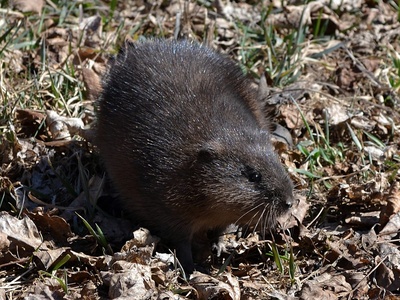
Muskrat
A common resident of boreal wetlands, the muskrat is a semi-aquatic rodent that builds dome-shaped lodges from vegetation. It is an important part of the food web and a historic furbearer.
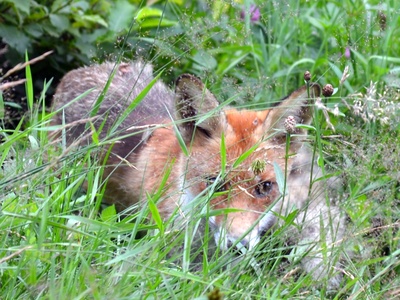
Red Fox
The highly adaptable red fox is a common sight in the boreal forest. It is a cunning and resourceful hunter, using its keen senses to locate small mammals moving beneath the snow.
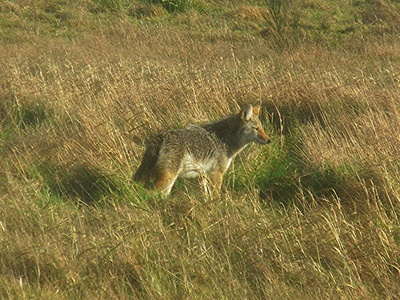
Coyote
The coyote’s range has expanded dramatically into the boreal forest. This adaptable canid is a versatile hunter and scavenger, capable of thriving in a wide variety of habitats.
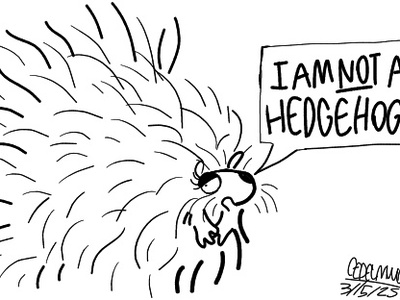
North American Porcupine
The second-largest rodent in the north, the porcupine is well-known for its formidable defense of sharp quills. It is a slow-moving, deliberate climber that feeds on tree bark during the winter.
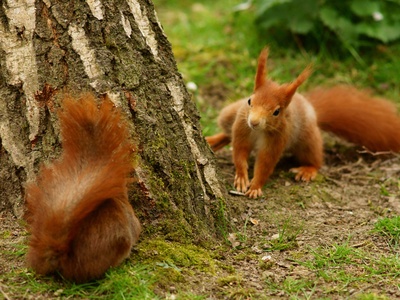
Red Squirrel
This feisty and vocal squirrel is a ubiquitous resident of the taiga. It is a master at harvesting and storing conifer cones in large piles called middens, which provide a critical food source through winter.

Northern Flying Squirrel
This secretive, nocturnal rodent doesn’t truly fly but glides gracefully from tree to tree using a flap of skin. It is a key disperser of truffle spores, which are essential for tree health.
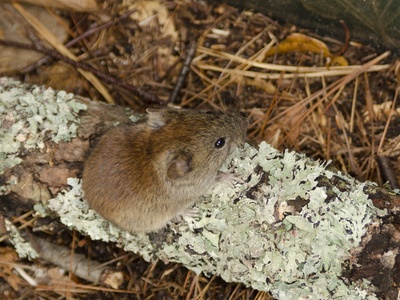
Southern Red-backed Vole
This small, reddish-brown vole is one of the most abundant mammals in the boreal forest. It is a vital food source for a wide range of predators, from owls and martens to weasels and foxes.
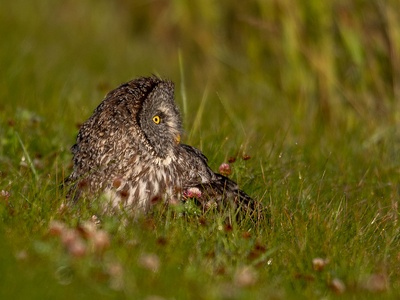
Great Gray Owl
One of the world’s largest owls, the Great Gray Owl is a master of the silent hunt. It uses its phenomenal hearing to detect and plunge through deep snow to catch unsuspecting rodents below.
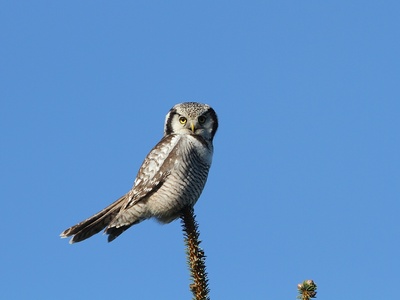
Northern Hawk Owl
Behaving more like a hawk than a typical owl, this species is a fast and agile daytime hunter. It often perches at the very top of a spruce tree, scanning the landscape for movement.
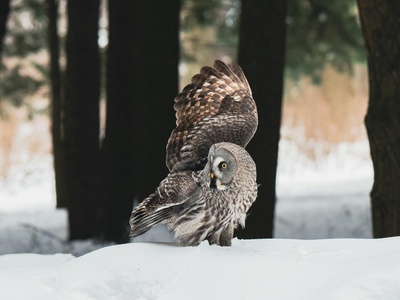
Boreal Owl
A small, secretive owl of the deep boreal forest, this nocturnal hunter is rarely seen. It relies on its acute hearing to find small mammals in the dark, nesting in cavities created by woodpeckers.
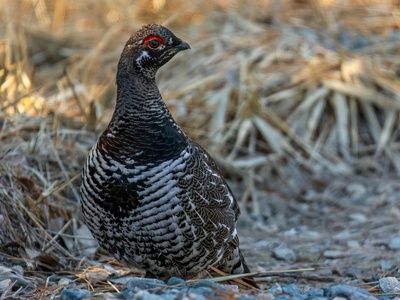
Spruce Grouse
Often called the “fool hen” for its tame nature, this grouse is a conifer specialist. It survives winter by almost exclusively eating spruce and pine needles, a diet toxic to most other animals.
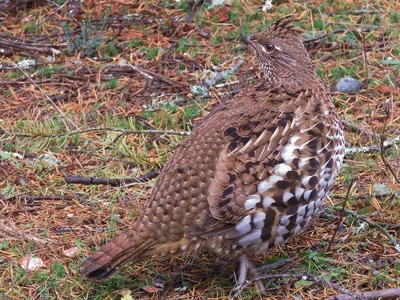
Ruffed Grouse
Famous for the male’s territorial drumming sound that echoes through the spring woods, the ruffed grouse is a master of camouflage. In winter, it will dive into deep, soft snow to stay insulated overnight.
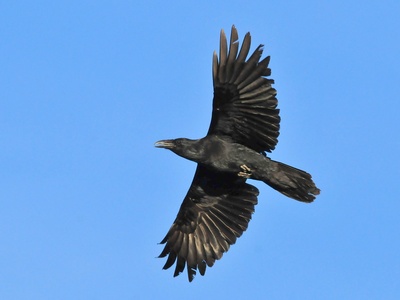
Common Raven
This highly intelligent and adaptable bird is a master of the boreal skies. Ravens are known for their complex social behaviors, problem-solving abilities, and their role as opportunistic scavengers.
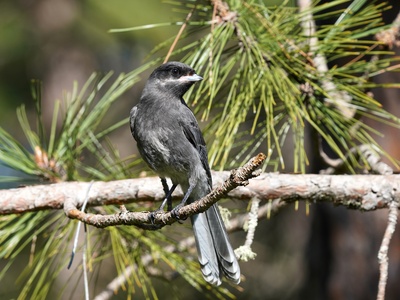
Canada Jay
Known as the “Whiskey Jack,” this clever bird is a year-round resident famous for its remarkable ability to store thousands of food items to survive the harsh winters, often showing little fear of humans.
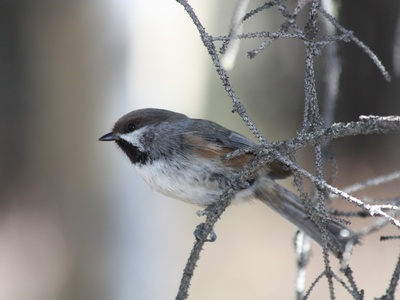
Boreal Chickadee
A true northern specialist, the boreal chickadee is perfectly adapted to cold. This small but tough bird forages for insects and seeds year-round, often in flocks with other small birds.
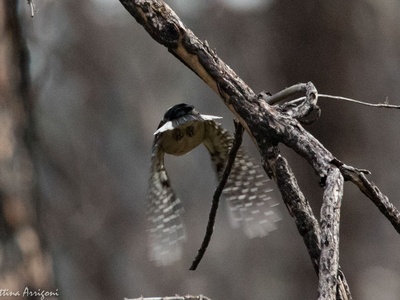
American Three-toed Woodpecker
This specialized woodpecker has only three toes, giving it extra power for hammering into trees. It plays a key role in controlling bark beetle populations, especially in burned or diseased forests.
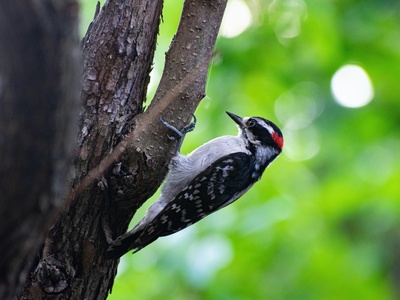
Black-backed Woodpecker
A specialist of burned forests, this woodpecker moves into areas after a fire to feast on the abundant wood-boring beetle larvae. Its black back provides perfect camouflage against charred tree trunks.
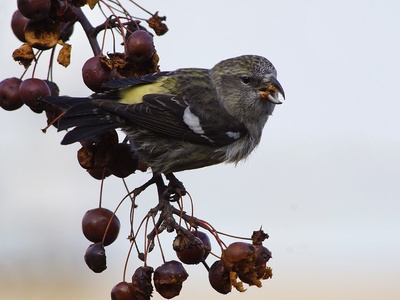
White-winged Crossbill
This finch has a bizarre and highly specialized beak with crossed tips, used like tweezers to extract seeds from spruce and tamarack cones. Their movements are nomadic, following the best cone crops.
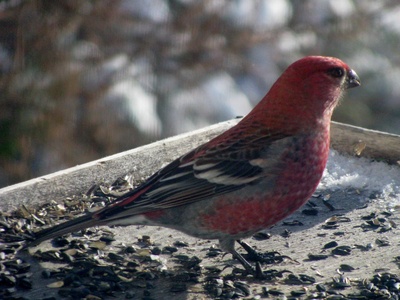
Pine Grosbeak
One of the largest and most placid finches of the boreal forest, the Pine Grosbeak uses its stout bill to eat seeds, berries, and tree buds, bringing a splash of rosy red to the winter landscape.
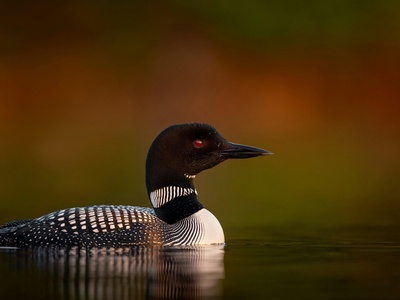
Common Loon
The haunting call of the common loon is the very sound of the northern wilderness. This expert diver is a master of the water but clumsy on land due to its rear-placed legs.
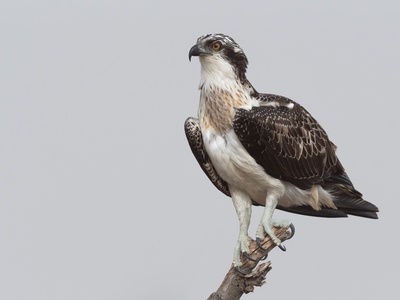
Osprey
Known as the “fish hawk,” the osprey is a magnificent raptor that hunts over boreal lakes and rivers. It can be seen plunging feet-first into the water to snatch fish with its specialized talons.
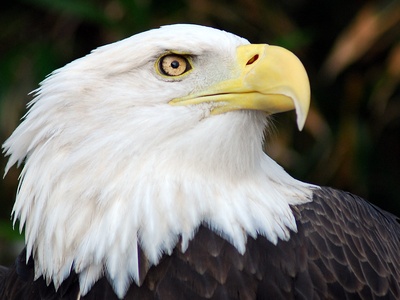
Bald Eagle
A powerful symbol of the wilderness, the bald eagle is a common sight near boreal waterways. While a skilled hunter of fish, it is also an opportunistic scavenger, feeding on carrion when available.
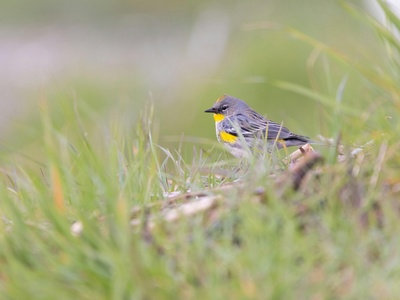
Yellow-rumped Warbler
This energetic and abundant songbird is a herald of spring in the taiga. It is a highly adaptable forager, catching insects in mid-air or picking them from branches with equal skill.
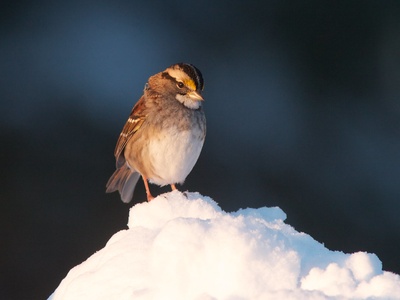
White-throated Sparrow
The clear, whistling song of the white-throated sparrow is a classic sound of the boreal forest in summer. This handsome sparrow is often found scratching for food in the leaf litter.
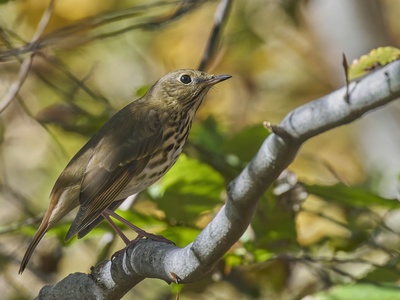
Hermit Thrush
Often heard but not seen, the hermit thrush sings one of the most beautiful and haunting songs in the North American woods. Its flute-like, echoing melody is a hallmark of the boreal evening.
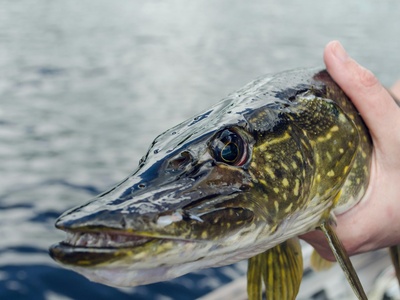
Northern Pike
A voracious and formidable ambush predator, the northern pike is the wolf of boreal lakes and rivers. It lurks in weedy areas, exploding out to catch fish, frogs, and even small ducks.
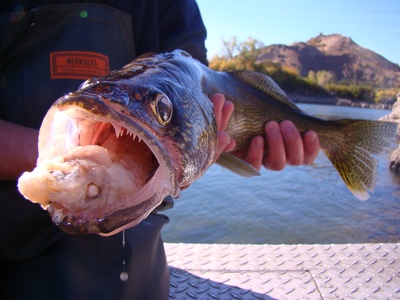
Walleye
Named for its large, opaque eyes that allow it to hunt effectively in dark or murky water, the walleye is a prized game fish. It is most active at dawn and dusk, preying on smaller fish.
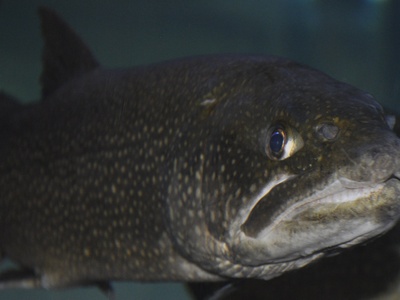
Lake Trout
A denizen of deep, cold boreal shield lakes, the lake trout is a top aquatic predator. This slow-growing, long-lived fish is highly sought after by anglers and is sensitive to environmental changes.
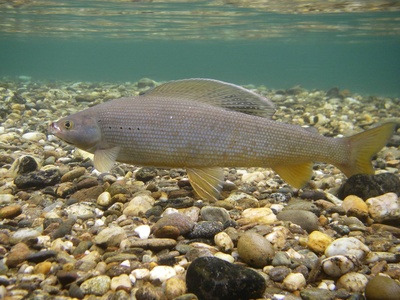
Arctic Grayling
Instantly recognizable by its stunning, sail-like dorsal fin, the Arctic grayling is a beautiful fish of cold, clear northern rivers and lakes. It is often seen rising to the surface to sip insects.
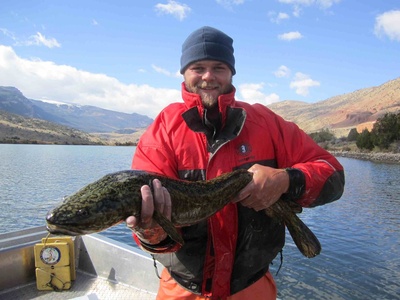
Burbot
The only freshwater member of the cod family, the burbot is a unique, eel-like bottom-dweller. This nocturnal predator uses a single barbel on its chin to feel for prey in the dark depths.
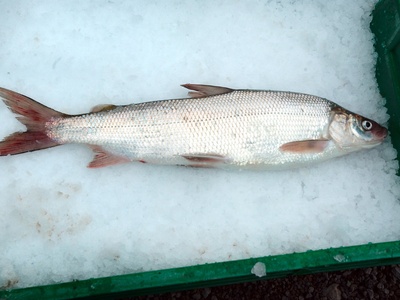
Lake Whitefish
A key species in the food web of many large boreal lakes, the lake whitefish is a schooling fish that feeds on small invertebrates on the lake bottom. It has long been a vital commercial and subsistence fish.
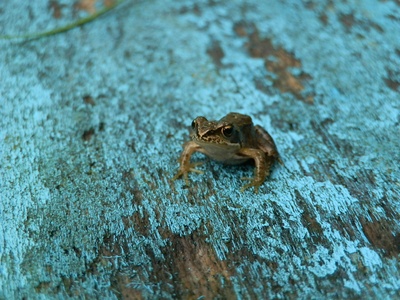
Wood Frog
This incredible amphibian has a remarkable superpower: it can survive being frozen solid during the winter. It is one of the very first frogs to begin calling and breeding, often when ice still lingers.
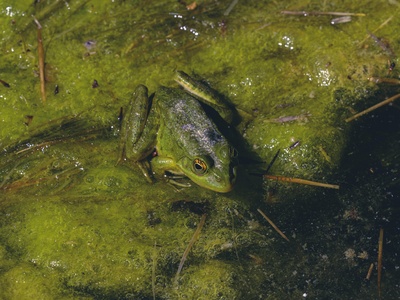
Boreal Chorus Frog
One of the earliest signs of spring in the boreal forest is the chorus of this tiny frog. Its surprisingly loud, trilling call fills wetlands and ponds shortly after the ice melts.
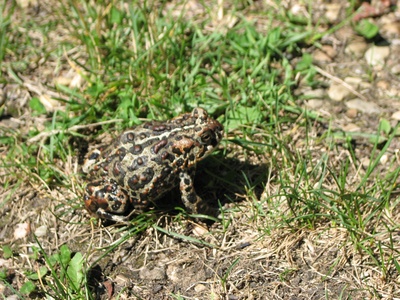
Canadian Toad
Adapted to the sometimes dry and harsh conditions of the boreal plains, the Canadian toad spends much of its time underground. It emerges after rains to feed on insects and to breed in shallow pools.
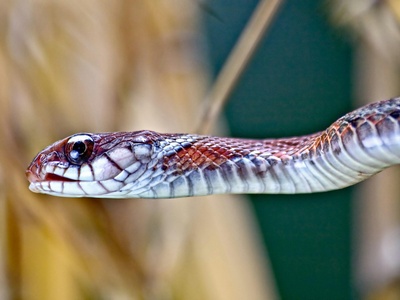
Common Garter Snake
This snake is one of the few reptiles able to withstand the cold boreal climate. It survives the long winters by gathering in large numbers in communal dens below the frost line.
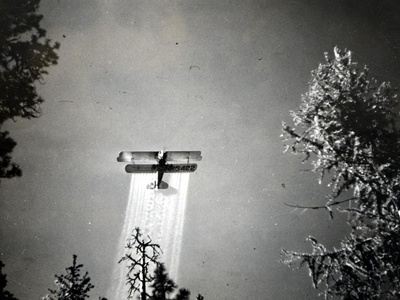
Spruce Budworm
This small, native moth larva is a major force of nature in the boreal forest. Its populations explode in massive outbreaks every few decades, killing mature fir and spruce trees and resetting the forest cycle.
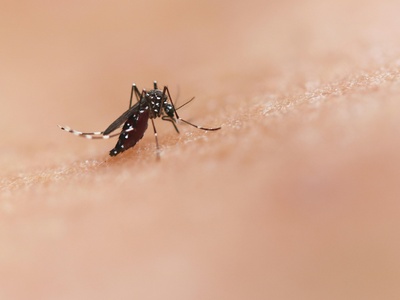
Mosquito
Infamous to visitors but essential to the ecosystem, mosquitoes are incredibly abundant in the boreal summer. Their aquatic larvae are a vital food source for fish and insects, and the adults feed countless birds.
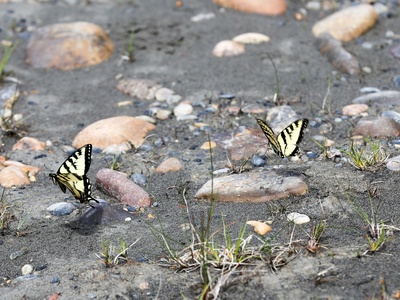
Canadian Tiger Swallowtail
This large, beautiful butterfly is a welcome sight in the boreal summer. The caterpillars feed on the leaves of trees like aspen and birch, overwintering as a chrysalis to emerge as an adult in spring.
